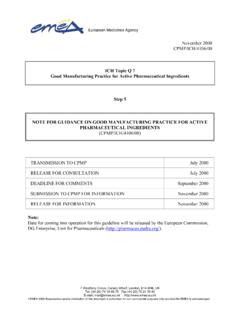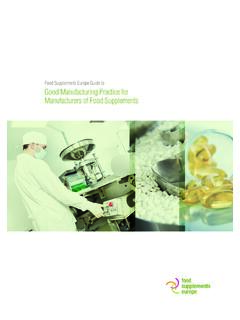Transcription of GOOD MANUFACTURING PRACTICE - Plastics Industry …
1 FOOD, DRUG, AND COSMETIC PACKAGING MATERIALS COMMITTEEJune 2018 good MANUFACTURING PRACTICEG uideline for the Plastic Food Packaging Supply ChainGOOD MANUFACTURING PRACTICEG uideline for the Plastic Food Packaging Supply ChainFOOD, DRUG, AND COSMETIC PACKAGING MATERIALS COMMITTEEJune 2018 Plastics Industry Association ( Plastics )Food, Drug, and Cosmetic Packaging Materials AND DISCLAIMERThis report is copyright 2018, Plastics Industry Association ( Plastics ) Food, Drug, and Cosmetic Packaging Materials Committee. All rights publication has been prepared by Plastics as a service to the Industry .
2 This document is intended for use as a general reference tool, and is not intended to and does not establish any Industry standards or duty of care. Any examples included in the publication are not intended to be directed to any particular product and should not be considered an appropriate model without further considerations to a company s good MANUFACTURING PRACTICE program. This publication is not intended to provide specific advice, legal or otherwise, on the development of good MANUFACTURING practices and procedures. Readers should consult with their own legal and technical advisors, their suppliers, and other appropriate sources, which contain information about known and reasonably foreseeable health and safety risks for their proprietary products and processes.
3 Readers are solely responsible for and assume the risk arising from the use of the information provided in this publication. Plastics , its members, contributors, agents, and attorneys make no warranty, express or implied, as to the accuracy, completeness, or suitability of the information provided herein, and do not assume any responsibility for the user s compliance with applicable laws and regulations. 2018 Plastics Industry Association ( Plastics ) 1425 K Street, NW, Suite 500 Washington, DC 20005 SUMMARY OF CHANGE 1 PREAMBLE 2 INTRODUCTION 4 CATEGORY 1 GMP PLAN 5 CATEGORY 2 MANAGEMENT LEADERSHIP AND PERSONNEL 5 CATEGORY 3 HYGIENE AND PEST CONTROL 5 CATEGORY 4 DOCUMENTATION 5 CATEGORY 5 FLOW OF OPERATIONS 5 Raw Material Specifications and Acceptance Criteria 5 Process and Product Specifications and Evaluation 5 Facilities and Equipment 6 Laboratories 6 Contamination Prevention
4 6 Packaging and Labeling 6 Storage, Warehousing and Transportation 6 CATEGORY 6 DEFENSE AND PRODUCT SECURITY 6 CATEGORY 7 TRACEABILITY 7 CATEGORY 8 INCIDENT AND NON-CONFORMANCE PROTOCOLS 7 CATEGORY 9 INTERNAL AND SUPPLIER ASSESSMENTS 7 CATEGORY 10 CONTRACTED WORK 7 CATEGORY 11 MANAGEMENT OF CHANGE 7 GLOSSARY 9 SELECTED SOURCES OF INFO ON Plastics -RELATED good MANUFACTURING PRACTICE 10 CONTENT1 Plastics good MANUFACTURING PRACTICE | GuidelinesSUMMARY OF CHANGEThe Introduction has been revised as follows: This GMP Guideline applies to facilities that are not required to register with FDA under Section 415 of the Federal Food, Drug, and Cosmetic Act as facilities that manufacture, process, pack, or hold food for human or animal consumption and are thus not subject to FDA s Final Rule for Preventive Controls for Human Food.
5 FDA s GMP for direct food additives will transfer from 21 CFR Part 110 to 21 CFR Part 117 upon the effective dates specified in FDA s Final Rule for Preventive Controls for Human Food and FDA s Final Rule: Extension and Clarification of Compliance Dates for Certain Provisions of Four Implementing Glossary has been revised as follows: The definition of food clarifies that 21 CFR Part excludes food contact substances, defined in Section 409(h)(6) of the Federal Food, Drug, and Cosmetic Act as any substance intended for use as a component of materials used in MANUFACTURING , packing, packaging, transporting, or holding food if such use is not intended to have any technical effect in such food.
6 The Selected Sources section has been updated as follows: The following note has been added for the reader: The URLs below were active and correct as of publication of this version of the Guideline. They are subject to change or break, however, and linked documents may not necessarily be the latest editions of the sources cited. Please take care to verify. Broken URLs were replaced, and references to outdated documents were deleted and/or updated to the latest versions. A link was added to FDA s Draft Guidance for Industry : Questions and Answers Regarding Food Facility Registration (Seventh Edition) Revised The Publically Available Specification (PAS) 220 and 223 documents, which informed the original Guideline published in 2012, have been replaced by the Technical Specifications ISO/TS 22002 1 and ISO/TS 22002 4, the latter for food packaging.
7 Once ISO published the requirements as Technical Specification (TS), they were benchmarked for FSSC. These are available at the following link: All references to FDA s Food and Cosmetic Security Preventive Measures Guidance have been removed, because this Guidance has been replaced by FDA s Final Rule for Mitigation Strategies to Protect Food Against Intentional Adulteration, which explicitly exempts food-contact substances from its good MANUFACTURING PRACTICE | GuidelinesPREAMBLEThis guideline for the Plastics Industry was prepared by representatives of numerous Plastics member companies which, themselves, comprise numerous links in the plastic food, drug.
8 And cosmetic packaging materials MANUFACTURING supply document is intended as a guide to assist employees whose responsibilities include assurance of their companies adherence to appropriate good MANUFACTURING practices (GMP). It is intended to serve as a general reference tool for companies and facilities throughout the plastic packaging supply chain, from resin manufacturer through packaging document does not establish a GMP program that would be appropriate for any particular facility. Rather, this document serves as a guide for topics and areas that should be considered during development of a GMP program for facilities not required to register with FDA under the Food Safety Modernization Act (FSMA) and thus not subject to FDA s Final Rule for Preventive Controls for Human Food.
9 Any GMP program must be tailored to a specific facility, its MANUFACTURING conditions, the nature of the product being manufactured, and the product s intended use in the packaging supply chain. It is hoped that the concepts and principles discussed below will be a useful tool to assist practitioners with developing an appropriate GMP program for their own good MANUFACTURING PRACTICE | Guidelines4 INTRODUCTIONThe concept of good MANUFACTURING PRACTICE (GMP) underpins the manufacture of all products regulated by the Food and Drug Administration (FDA).Food and food packaging must be manufactured under a GMP program that prevents contamination and ensures products will be safe.
10 The regulatory requirements for a well-designed GMP program vary by the type of product being produced and by the position of the product in the MANUFACTURING process and supply chain. GMP must always be considered with regard to the intended use of the product itself, and it is important for all companies that produce food packaging and other food contact materials to understand the appropriate GMP for their individual products. Manufacturers of food products have different GMP requirements than a company that manufactures, for example, a plastic liner that is used to hold the food , a manufacturer of an additive or resin that is used in the plastic liner will be subject to different GMP than a company converting those materials into a finished plastic liner.





